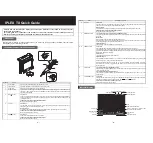
Features & Description
EPM1000 User’s Guide
9
Understanding the
EPM1000 Internal
Trigger
(continued)
The ranges differ by powers of ten. A full-scale signal on one range may
not trigger on the next higher range unless the trigger level is set to less
than 10%. For example, a near full-scale signal of 280 mJ on the 300 mJ
range is less than 10% of full scale on the next higher range (2 J) and
would not trigger the reading, so adjust the trigger level to less than 8%
for reliable triggering.
The trigger is synchronous with the leading edge of the pulse, but the
actual peak is determined algorithmically by sampling the input signal
near the trigger. From the trigger point forward, the algorithm searches
for peaks and from the trigger point back, it searches for a baseline.
The EPM1000 can be programmed to ignore triggers for a specified time
after a valid trigger. This prevents “false” triggers in pulse tails from
accidentally starting a new sample (see Figure 2). This amount of delay
time is called the Trigger Holdoff (see Operation -- Operation Settings --
Trigger Settings -- Trigger Holdoff). The EPM1000 is set at the factory
with a 1 ms trigger holdoff.
5%
10%
15%
Trigger
Level
Possible
False
Trigger
1 ms
2 ms
Figure 2: How a false trigger could occur
Artisan Technology Group - Quality Instrumentation ... Guaranteed | (888) 88-SOURCE | www.artisantg.com















































